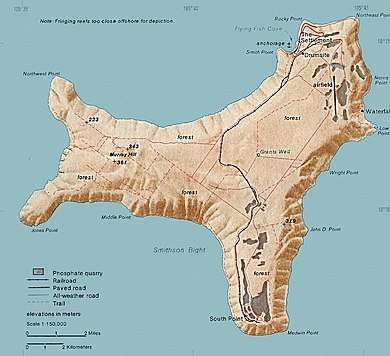Christmas Island Phosphate Co.'s Railway
The Christmas Island Phosphate Co.'s Railway was a 19.7 km (12¼ miles) long industrial railway between Flying Fish Cove and South Point on Christmas Island. The remains of the South Point station are now heritage-listed.
| Christmas Island Phosphate Co.'s Railway | |
|---|---|
 Peckett & Sons 1931 built 0-8-0 tender locomotive
 | |
| Technical | |
| Line length | 12.7 km |
| Track gauge | 1435 mm and 610 mm |
Tracks
The standard gauge track with 1435 mm (4 ft 8½ in) gauge was laid in stages between 1914 and 1920. It was primarily used for transporting phosphate from the mines, but it also transported passengers, such as the miners' children to school.[1] When phosphate mining ceased, the railway was taken out of use in 1987. The tracks have been lifted and scrapped by now. Various remains including a GE 44-ton switcher diesel engine are still on the island.
It ran from Drumsite to South PointSouth Point Settlement]]. It was extended from Drumsite to Phosphate Works in 1958 and to Phosphate Hill 1961.[1]
In addition the company operated a narrow gauge railway with 610 mm (2 ft) gauge on the island.[2]
Rolling stock
Locomotives
Forty steam and internal-combustion locomotives were used on the island. These were imported from Australia, Canada, Germany, the United Kingdom and the USA including three 70 ton geared Shay locomotives, a type of locomotive predominantly used within the USA.[2] According to the time table, the Shay locomotives needed 2 hours per trip, requiring 20–30 minutes on each journey for refuelling with wood and water. They hauled normally 16 steel hopper wagons of 15 tons tare and 22 tons load each, i.e. an average load of approximately 600 tons behind the tender.[3]
On the standard gauge were seven steam locomotives, from Lima Locomotive Works, Peckett & Sons and Robert Stephenson & Hawthorn in use. Additionally ten standard gauge internal combustion locomotives from Orenstein & Koppel, Whitcomb, Canadian Locomotive Company and General Electric were used.[2][1]
On the narrow gauge railway, there were twenty-three 2 ft gauge internal-combustion locomotives from Orenstein & Koppel, Robert Hudson, Baguley and Hunslet Engine Company, with the oldest dating from around 1912.[2]
Passenger vehicles
For passenger transport a Drewry railcar and three Wickham railcars with five trailers were used.[1] The key objective of the Wickham railcars was to provide rolling stock for the School Train. A few flat wagons were also modified for transporting passengers. These were for instance used for the Picture Train, to transport passengers to and from the island’s cinema. There were also two unusual rail vehicles for carrying passengers on an incline.[2]
References
- Christmas Island Light Railways issue 29 Spring 1969 pages 4-7
- David Jehan: Shays, Crabs and Phosphate. A History of the Railways of Christmas Island, Indian Ocean Archived 2014-02-12 at the Wayback Machine
- Christmas Island Phosphate Co.'s Railway New 0-8-0 Locomotive. Originally published in Locomotive, Railway Carriage & Wagon Review on 15 May 1931.